Introduction
Garlic has been cropped for centuries throughout the world. It is not only used as a spiced vegetable but also as a curative for many lifestyle-based diseases like cardiovascular diseases and other age-related diseases.1 Garlic based therapeutics has been utilized in India for more than 5000 years and in Chinese medicines for more than 3000 years.2 Garlic is generally processed into various forms including dried garlic powder, garlic flakes, raw garlic, garlic pulp and oil. Garlic, as an agricultural good, is rich in phosphorus, sulphur, potassium, selenium, vitamins and zinc.3 The processing of garlic is important as it activates the formation of a cascade of compounds that do not exist in the raw garlic. Quality of garlic products is estimated based on the flavour and colour of the garlic. The flavour of garlic is ascribed to the sulfur-containing volatiles known as allin. Allin is colourless, odorless, water-soluble amino acid present in the intact cells of garlic. By the action of an enzyme, allinase, allyl-S-cysteine sulfoxide (allin) is converted to diallylthiosulfinates (allicin) and finally disproportionately to disulfides and thiosulfinates. The activity of these compounds occurs when the garlic bulb is crushed thereby causing the release of allinase enzyme which plays a major role in enzymatic reaction required for the production of thiosulphinates. Garlic contains more sulphur compounds of about 1.1 to 3.5% when compared with onions which have 0.4 to 1.2%.4 However, garlic is a partially prone to spoilage and so some sort of processing is required to adapt excess production. Besides, the need for ready-to-cook products has increased lately. Garlic pulp is an alternative to hold the freshness of garlic. One of the main obstacles in preserving garlic pulp is its change of colour due to the activity of phenolic compounds, which also affects the shelf life and acceptability of the product. To overcome this problem, after the production of garlic pulp, thermal treatment of the pulp in the form of pasteurization is done to prevent the growth of microorganisms and enhance the shelf life of the product.
Pasteurization is a technique where heat treatment is given to the product to inactivate the natural enzymes and microorganisms through heating at a temperature below 100 ºC, thereby enabling the storage period. Heat treatment is also associated with quality deterioration. Certain compounds that are sensitive to light, temperature and chemical compounds are also affected. Since heat can change the organoleptic characteristics, advancement in process technologies is attempted to minimize the time of exposure to heat. Furthermore, consumers are demanding for less processed products with good quality. Pasteurization is traditionally accomplished by the exchange of heat, where heat is carried by conduction from hot water or steam to the product. The efficiency of this technique depends on the design of pasteurizer. On the other hand, ohmic heating promises better efficiency which is why it is been used in the food industry.5,6 In this method, food product which contains constituents that conduct electricity are subjected to electric current leading to heat generation, thereby causing conversion of electrical energy into thermal energy. In this process, instant heating and homogenous temperature distribution occur especially for liquid foods where electrical conductivity (EC) is high.7,8 This technology not only reduces thermal damage but also keeps off over-processing of food products when attaining higher temperatures. So, high-temperature short-time processing techniques are known to be effective in destructing enzymes that are responsible for the change in organoleptic characteristics.
The ohmic heating process is defined based on various factors including installation, process and product parameter. Electrical conductivity is one such parameter. The electrical conductivity of the food material is the main property during ohmic heating as it controls the rate of heating. The electrical conductivity is influenced by the nature of the product, temperature and voltage gradient. When the voltage gradient is high, the ohmic heating occurs at a faster rate, and the temperature rises rapidly in association with the electrical conductivity values.9 By internal energy generation, ohmic heating performs in both phases at the same time.10 Ohmic heating eliminates heat transfer surfaces and limits conduction and convection heat transfer, which permits food to heat at a faster rate and uniformly, resulting in the better gaining of energy.11 Hence, ohmic heating is considered as a best suited thermal processing method to process solid-liquid food mixture with less nutritional and organoleptic changes.12 Ohmic heating method to process food is considered as an environmentally friendly and energy-saving technique when compared to all the conventional techniques used today.13 During ohmic heating, when electric field is applied, destruction of microorganisms occurs which is due to the phenomenon of electroporation.14-18
To the best of our knowledge, no studies have carried out on pasteurization of garlic pulp by ohmic heating. Our study also aims at studying the degradation of bioactive compounds in ohmic heated garlic pulp during storage in refrigeration temperature. The results are compared with conventional heating (CH).
Materials and Method
Sample Preparation
Ooty 1 variety garlic is procured from a local market Vadapalani, India. Garlic is then graded, peeled and pulped using a domestic mixer. Freshly prepared garlic pulp is stored in a glass bottle for further analyses. The garlic pulp is then pasteurized ohmically and conventionally. 250 mL of garlic pulp is utilized for each treatment.
Heating Method
The same heating rate for pasteurization done by conventional and ohmic heating was employed to find the electrical effect of ohmic heating instead of thermal effect.
Conventional Heating (CH)
Pasteurization by conventional heating of the garlic pulp is done by heating 250 mL of garlic pulp in a stainless steel vessel. The garlic pulp is heated to 82 ºC and held for 2 min to increase the shelf life. Studies were done previous to optimize the holding time based on the microbial growth and quality parameter (i.e. colour). Temperature is noted for every 30 min to calculate the heating rate. During the process, the container was shaken to provide uniform heating.
Ohmicheating (OH)
Pasteurization by ohmic heating treatment is done in a 500 mL lab-scale acrylic chamber. The system consists of ammeter, voltmeter, power supply, titanium electrodes and a step-up transformer. The area of an ohmic heating cell used is 67.2 cm2. The titanium electrodes were placed at a distance of 6 cm. A Teflon coated thermometer is utilized for the measurement of temperature at various locations of the ohmic heating cell. A microprocessor board is fitted to observe the current and applied voltage.19
250 mL garlic pulp is placed between two titanium electrodes placed in the test cell and thermocouples were fitted to measure the temperature. The garlic pulp was then ohmically heated at three voltage gradients: 13.33, 20 and 26.66 V/cm. The garlic pulp is heated from 32 to 82 ºC and held for 2 min as similar to the conventional heating process. As mentioned before, the holding time is optimized. The temperature and ammeter values are observed simultaneously to calculate the heating rate and electrical conductivity. The temperature of garlic pulp was measured at different positions in the test cell and the difference was about 1 ºC.19
Electrical Conductivity
Electrical conductivity (σ) was found from the sample’s resistance and cell’s geometry with the following equation 20:

where σ is the electrical conductivity (S/m); A is the area of the cell (m2); L is the gap between two electrodes; I is the current (A), and V is the voltage (V).
Microbial Study
Microbial growth studies intend the shelf-life stability of the product. Garlic pulp was analysed for microbial growth before and after processing according to the standard method.21
Total Bacterial Count
3.25 g of nutrient broth media and 2% agar was suspended in 250 mL of water followed by sterilization at 121 ºC temperature, 15 lbs pressure for 15 min and pH was adjusted to 7.4 at 25 ºC. 1 g garlic pulp is serially diluted with distilled water. Pour plating technique was done after dilution. Triplicate plates were utilized for each dilution. It is then incubated at 37±2 ºC for 48 h.
![]()
Physiochemical Analyses of Garlic Pulp
Garlic pulp was analysed for pH, and colour before and after processing.
pH Measurement
The pH of garlic pulp is evaluated using digital pH meter (Cyber pH 14 L). Before measuring, the pH meter is calibrated with a buffer 7 solution.22
Colour Analysis
Colour of the garlic pulp was measured using Hunter colorimeter (Colour Quest) before and after processing. The instrument was standardized with white tile. The results were expressed in terms of L*, a* and b*, where L* is for lightness, a* is for redness or greenness and b* is for blueness and yellowness. From the expressed values, the total colour difference is calculated using the following formula.23
![]()
Analysis of Bioactive Compounds
Bioactive compounds such as alliin, pyruvic acid and diallyl disulphide play significant roles in garlic. The quantification of these bioactive compounds in garlic is analysed by High-performance liquid chromatography (HPLC). Standards of bioactive compounds such as alliin, pyruvic acid and diallyl disulphide are obtained from SIGMA-ALDRICH. The standard solution at different concentrations was prepared with 90% methanol containing 0.01 N HCl, for calibration.
Garlic sample is prepared in a 50 mL glass beaker by mixing 1 g of garlic pulp with 90% methanol containing 0.01N HCl and it is centrifuged at 1000 rpm for 15 min. The obtained supernatant was then analyzed for bioactive compounds by HPLC. Extracts were injected into HPLC (Shimadzu UFLC) assembled with a C18 column. Acetonitrile and water were used as a mobile phase in 84:16 (V/V) ratio and the flow rate of the column was 1 mL/min. The standards were calibrated with various concentrations by measuring absorbance at 205 nm.24
Results and Discussion
Change in Temperature During Ohmic Heating
The temperature increased for every 30 sec. Bubble point for garlic pulp was observed at 82ºC. In ohmic heating, the time taken to reach 82ºC decreased as the applied voltage gradient increased as in fig.1. The outcome of the voltage gradient on the time taken to reach the bubbling point was statistically significant. Garlic pulp took 90 sec to bubble when ohmic treated at 13.33 V/cm, whereas it took 75 sec and 55 sec to bubble when treated at 20 and 26.66 V/cm, respectively. This is because the temperature depends on the voltage and current running through the sample. Similarly, in conventional heating, the time taken to bubble was on par with ohmic treatment at 26.66V/cm. Heating rate of conventional method and ohmic heating at 26.66 V/cm matched and this eliminates any deviation in the thermal procedure. Varying voltage gradient during ohmic heating was applied to find the corresponding heating rate with conventional heating. However, ohmic heating could be executed by applying constant voltage gradients, based on which quicker and uniform heating of pulp takes place. Similar results were reported on ohmic heating of ginger paste using a voltage gradient in the range of 5-13 V/cm.25 When lemon juice was ohmic heated from 30 to55 V/cm, it took 45 sec to reach the bubbling temperature of 74 ºC.26 Similarly, when tomato juice was ohmic heated from 50 to 70V/cm, it took 48 sec to reach 80 ºC.27 Current passing through the sample is high at high voltage gradient, thus increasing the rate of heat generation and decreasing the time to reach a bubbling point. When tomato paste is ohmic heated at 6 and 14 V/cm, it took 235 and 38 sec to reach 96 ºC.28
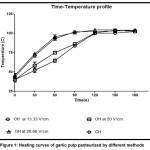 |
Figure 1: Heating curves of garlic pulp pasteurized by different methods Click here to View figure |
Change in electrical conductivity of ohmic pasteurized garlic pulp
The electrical conductivity increased linearly till the bubbling temperature as shown in fig.2. Electrical conductivity increased with temperature as is anticipated and consistent with literature data. The increase in electrical conductivity during ohmic heating is due to increase in the mobility of ions that are caused due to structural changes in the biological tissue such as breakdown of cell wall protopectin, non-conductive gas bubbles expulsion, and decrease in aqueous phase viscosity. Once the garlic pulp starts to bubble, a decrease in electrical conductivity was observed. This could be due to electrolytic hydrogen bubble formation.28 There was a significant difference between electrical conductivities at different voltage gradients. The electrical conductivity of garlic pulp was in the range of 4.5 to 8 S/m. The highest electrical conductivity was observed at 26.66 V/cm. Similar results were also observed in tomato juice where electrical conductivity was highest at 70 V/cm, followed by 60 and 50 V/cm.29 Whole egg, white egg and yolk were ohmically heated and described that electrical conductivity increased linearly with temperature.26 The results were incomparable with the electrical conductivity of banana pulp.19 Other researchers have also proved that with an increase in temperature electrical conductivity increase.7,26 This increase could be due to reduced drag movement of ions. The results were on par with that of peach puree.20 The experimental electrical conductivity results of garlic pulp observed to follow a linear fashion with increasing temperature. The linear regression model was used to fit experimental data.
Where M and C are constants and T is the temperature (ºC). Highest regression coefficient value (R2>0.99) indicated the suitableness of the linear model for variation in conductivity with temperature. Higher the voltage gradient, higher was the regression coefficient (i.e. R2= 0.997 at 26.66 V/cm) as in table 1. Similar results were also reported in tomato juice.29 These results can be used by industry to analyse the effectiveness of the process when ohmic heating technology is used.30
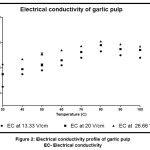 |
Figure 2: Electrical conductivity profile of garlic pulp EC- Electrical conductivity Click here to View figure |
Table 1: The constants and coefficients of time and temperature relationships of ohmic heated garlic pulp ohmic
| Voltage gradient (V/cm) | M | C | R2 |
| 13.33 | 0.052 | 3.141 | 0.974 |
| 20 | 0.045 | 4.051 | 0.983 |
| 26.66 | 0.035 | 5.277 | 0.997 |
Change in microbial content of garlic pulp during storage
Bacterial growth in unpasteurized and pasteurized garlic pulp during the storage is represented in fig. 3. The bacterial growth was observed to be less during the storage period of ohmic heated pulp when compared to the conventionally heated pulp. The number of bacterial colonies in vegetable pulp is limited up to 10 CFU/g. The total plate count of unpasteurized garlic pulp was 3 CFU/g. There was no bacterial growth in the ohmic heated garlic pulp after processing. The total bacterial count showed a significant increase with the increase in storage time. During the storage period in refrigeration temperature, garlic pulp unpasteurized started getting spoiled after 20 days, those processed by conventional heating showed rapid bacterial growth after 35 days; whereas ohmic heated garlic pulp could prevent spoilage up to 60 days. This increase could be due to the change in pH during storage time. Hence it is concluded that ohmic heating at 26.66 V/cm is sufficient to prevent spoilage in garlic pulp. There was complete inactivation of bacteria when orange juice is ohmically heated.31 Similarly, D value was reduced in ohmic pasteurized milk when compared to conventional heating.32 The same trend was also followed in aonla pulp.33 When apple juice was ohmically heated at 58 and 60ºC, the survival level of cells of food borne pathogens reduced below the detection limit of 1 log CFU/ml within 30 sec of treatment. The effect of ohmic heating on inactivation of microorganism is related to species and stage of growth. For instance, E.coli O157:H7 in tomato juice is more resistant to ohmic heating than L.monocytogenes.34 Total plate count in buffalo milk, when ohmic heating at varied voltages showed a larger reduction than conventional heating.35 Similarly, when orange juice is ohmic heated 50 Hz for various time interval, it showed a complete inactivation of bacteria,yeast and molds.36 Ohmic heating involves transition of alternating electric current through food components thereby genetrating heat through electrical resistance. The electric field and the generation of heat can facilitate the effect of pasteurization. The microbial inactivation depends on the current and duration of treatment.37,38
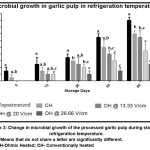 |
Figure 3: Change in microbial growth of the processed garlic pulp during storage in refrigeration temperature. a-cMeans that do not share a letter are significantly different. OH-Ohmic Heated; CH- Conventionally heated Click here to View figure |
Physiochemical Analysis of Pulp
After processing by ohmic and conventional methods, garlic pulp was cooled and poured in glass bottles. The shelf life of the garlic pulp was then studied under refrigeration temperature. Garlic pulp when unpasteurized, started showing microbial spoilage in 15 days. And so, the biochemical analyses of the garlic pulp processed by ohmic heating and conventional heating were done for every 7 days and the microbial analyses were done for every fortnight.
Change in pH of garlic pulp during storage
The biochemical analyses of the garlic pulp were done for the unpasteurized and pasteurized garlic pulp. The pH of the garlic pulp was 6.05. When they are pasteurized, the pH increased due to the application of heat and electrode reaction with the heating medium. pH has increased to 6.06, 6.07 and 6.11, when garlic pulp was ohmic heated at 13.33, 20 and 26.66V/cm and 6.08 in the conventionally pasteurized pulp. But, during the storage period decrease in pH was observed as shown in fig. 4. The pH of the ohmic heated garlic pulp decreased at a lesser rate than conventionally heated garlic pulp. In refrigeration temperature, unpasteurized garlic pulp showed a percentage increase of 4.98%, whereas garlic pulp conventionally heated showed 2.35% decrease. And ohmic heated garlic pulp at 13.33 and 26.66 V/cm showed a percentage decrease of 0.99 and 0.827%, respectively. Less percentage change was observed in tomato paste when ohmic heated at 6-14 V/cm.28 A similar trend for pH was reported in ohmic heated pomegranate juice. In other studies, pH of peaches changed from 4.2 – 4.4 during storage.39 This change in pH was mainly because of the electrochemical reaction of the electrode with the garlic pulp. The electrochemical reaction causes corrosion reaction and hydrolysis between the electrode and the sample, leading to loss of buffering capacity.40,41 The electrode corrosion happens through electro-dissolution caused by low-frequency alternating current. Lower pH had a significant effect on the stability of microbial spoilage of garlic pulp. Pasteurization by ohmic heating could prevent the growth of microbial for up to 60 days, by lowering the pH during storage. Previous studies were reported in pretreated ginger paste.42
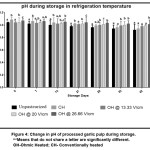 |
Figure 4: Change in pH of processed garlic pulp during storage. a-cMeans that do not share a letter are significantly different. OH-Ohmic Heated; CH- Conventionally heated Click here to View figure |
Colour change in garlic pulp during storage
Colour is a vital parameter for the acceptability of the product. Colour was affected by the applied voltage. After the treatment, the total colour difference of the garlic pulp ohmic heated at 26.66 V/cm is low, due to less residence time. During the storage period, the total colour difference increased rapidly in unpasteurized garlic pulp than the pasteurized pulp as shown in fig.5a and b. This increase is due to the degradation which is associated with the browning of garlic pulp.36 Owing to the presence of metal ions and oxygen, browning takes place. Analyzing the pasteurized garlic pulp, the total colour difference of the conventionally heated and ohmic heated (13.33 V/cm) increased at the same rate up to 14 days and after that conventionally heated pulp showed rapid progression in colour degradation. The change in colour in ohmic heated garlic pulp is associated with the electrode corrosion. Food substance is generally rich in ligands and during ohmic heating, via electrode corrosion transition of metal ions takes place leading to produce several coordination complexes, which are essential minerals for processed foods. These metal complexes have colour which alters the colour of the processed food. The use of low electric field leads to high colour changes, which could be due to occurrence of electrochemical reactions.43 Similar trends were observed in banana puree. When RTE pineapple samples were ohmically treated at 20 and 30 V/cm, reduced polyphenol oxidase activity was observed.44 No colour change was noticed when pea puree is ohmically heated at 20 V/cm.45
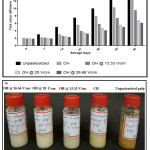 |
Figure 5: (a) Total colour difference in processed garlic pulp during storage in refrigeration temperature (b) garlic pulp after 60 days of storage in refrigeration temperature. OH-Ohmic Heated; CH- Conventionally heated Click here to View figure |
Change in bioactive content of garlic pulp during storage
Garlic contains some major bioactive compounds including alliin, pyruvic acid, diallyl disulphide, etc that play an important role in the functional properties. During processing and storage, degradation of bioactive compounds happened as in figs. 6a, 6b, and 6c. Calibration of the standards was done and the linear regression equation for alliin, pyruvic acid and diallyl disulphide is summarized in Table 2. The retention time for alliin, pyruvic acid and diallyl disulphide is 1.6, 1.8 and 3.0 min, respectively. The retention time depends upon the gas flow rate, length of the column and temperature difference between column and oven. Alliin is a major sulphur compound found in garlic. It helps in releasing allicin when garlic is crushed. Allicin is an unstable compound which is responsible for the pungency of garlic. Before storage, unpasteurized garlic pulp has alliin, pyruvic acid and diallyl disulphide contents of 10.12, 33.09 and 13.16 µg/mL, respectively. After the storage period, the bioactive compounds were found to have a percentage decrease of 92.34, 100 and 74.7% in alliin, pyruvic acid and diallyl disulphide content, respectively. Alliin content was 4.71, 3.73, 5.33 and 8.831 µg/mL when garlic pulp is conventional pasteurized and ohmic pasteurized at 13.33, 20, 26.66 V/cm, which showed a percentage decrease of 59.2, 51.6, 39.6 and 21.5%, respectively after the storage period of 45 days. In the same way, pyruvic acid content was 22.97, 21.42, 27.16 and 30.28 µg/mL when garlic pulp is conventional pasteurized and ohmic pasteurized at 13.33, 20, 26.66 V/cm, which showed a percentage decrease of 100, 100, 56.77 and 31.83%, respectively after the storage period. Also, diallyl disulphide content of garlic pulp was 4.64, 3.59, 7.215 and 9.04 µg/mL when it is conventional pasteurized and ohmic pasteurized at 13.33, 20, 26.66 V/cm, which showed a percentage decrease of 68.79, 68.09, 53.6 and 32.37%, respectively after the storage period. Bioactive compounds are retained at its best in the garlic pulp ohmically heated at 26.66 V/cm when compared to other treatments. This could be due to less residence time. Similar studies were reported in literatures on retention of ferrulic acid, caffeic acid, p-coumaric acid, chlorogenic acid, and two flavonoid compounds, namely, myricetin and rutin in yacon leaves. In this study high amount of flavanoid and phenolic compounds was observed when yacon leaves are ohmically heated. Higher retention of bioactive compounds were reported by other literatures including polyphenols from red pomace, phytochemicals from potato.46-48 Rapid heating during ohmic heating, reduces the overall time taken for processing which has direct effect in reducing the destructive effect of bioactive compounds. Another important factor for responsible for release of more biological compounds from cellular structure is the effect of electroporation.49,50
Table 2: HPLC output of standards
| Compound | Regression equation | Correlation coefficient R2 |
| Alliin | y = 2E+06x – 1E+06 | R² = 0.986 |
| Pyruvic acid | y = 79076x – 1E+06 | R² = 0.984 |
| Diallyl Disulphide | y = 22206x – 28583 | R² = 0.982 |
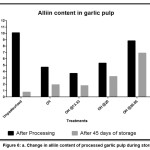 |
Figure 6: a. Change in alliin content of processed garlic pulp during storage. Click here to View figure |
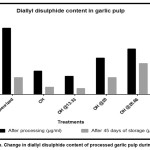 |
Figure 6: b. Change in diallyl disulphide content of processed garlic pulp during storage. Click here to View figure |
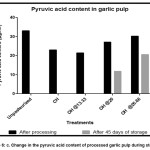 |
Figure 6: c. Change in the pyruvic acid content of processed garlic pulp during storage. Click here to View figure |
Conclusion
The garlic pulp was pasteurized by ohmic heating and conventional heating. Ohmic heating was done at three different voltage gradients and it is observed that with an increase in voltage gradient, heating time decreased. Electrical conductivity increased with temperature and voltage gradient. During the storage period, the physicochemical properties including pH, and colour best retained in the garlic pulp ohmic heated at 26.66 V/cm. While the conventionally pasteurized and unpasteurized garlic pulp could not retain the properties throughout the storage time. Garlic pulp ohmic heated at 26.66 V/cm extended shelf life upto 60 days, on the other hand, conventionally heated pulp showed up to 27 days and unpasteurized garlic pulp could not be stored more than 15 days in refrigeration temperature. Likewise, bioactive compounds including alliin, pyruvic acid and diallyl disulphide showed a loss at greater extent after the storage period in conventional pasteurized and unpasteurized garlic pulp, when compared to ohmic pasteurized garlic pulp. Results of ohmic heating show that no any modification in garlic pulp occurred due to application of electric current. Ohmic heating can be used as an advanced and rapid heating technique in industrial processing.
Acknowledgement
K. A. Athmaselvi plotted the master plan for the project, evaluated and interpreted the results. Poojitha P who has done the analysis, tabulated and interpreted data and wrote the article.
Funding Sources
The author(s) received no financial support for the research, authorship, and/or publication of this article.
Conflict of Interest
The authors do not have any conflict of interest.
References
- Ratti C, Araya-Farias M, Mendez-Lagunas L, Makhlouf J. Drying of Garlic (Allium sativum) and Its Effect on Allicin Retention. Drying Technology. 2007;25:349–356.
- Rivlin RS. Historical perspective on the use of garlic. Journal of Nutrition. 2001;131:951S-954S.
- Brewster JL. The physiology of the onion. Horticulture abstracts. 1977;47:17-23.
- Patra AK. Dietary Phytochemicals and Microbes. Springer; 2012.
- Butz P, Tauscher B. Emerging technologies: chemical aspects. Food Research International 2002;35(2-3):279–284.
- Demirdoven AH, Baysal T. Effects of electrical pre-treatment and alternative heat treatment applications on orange juice production and storage. Food and Bioproducts Processing. 2015;94:443–452.
- Icier F, Yildiz H, Baysal T. Polyphenoloxidase deactivation kinetics during ohmic heating of grape juice. Journal of Food Engineering. 2008;85:410-417.
- Jakób A, Bryjak J, Wójtowicz H, Illeová V, Annus J, Polakovic M. Inactivation kinetics of food enzymes during ohmic heating. Food chemistry. 2010;123:369–376.
- Nistor O-V, Botez E, Luca E, Mocanu GD, Andronoiu DG, Timofti M. OH process characterizations during apple puree processing. Journal of Agricultural Process Technology 2013;19(2):228- 236.
- Palaniappan S, Sastry SK. Electrical conductivity of selected solid foods during ohmic heating. Journal of Food Process Engineering. 1991a;14:221-236.
- Allen K, Eidman V, Kinsey J. An economic-engineering study of ohmic food processing. Vol 501996.
- Rahman M, Shafiur. Handbook of Food Preservation. Newyork: CRC Press.; 1999.
- Kemp MR, Fryer PJ. Enhancement of diffusion through foods using alternating electric fields. Innovative Food Science & Emerging Technologies. 2007;8:143-153.
- An HJ, King JM. Thermal characteristics of ohmically heated rice starch and riceflours. journal of Food Science. 2007;72(1):C84-C88.
- Lima M, Heskitt BF, Burianek LL, Nokes SE, Sastry SK. Ascorbic acid degradation kinetics during conventional and ohmic heating. Journal of Food Processing and Preservation. 1999;23(5):421-443.
- Kulshrestha S, Sastry SK. Frequency and voltage effects on enhanced diffusion during moderate electric field (MEF) treatment. Innovative Food Science & Emerging Technologies. 2003;4(2):189-194.
- Sensoy I, Sastry SK. Ohmic blanching of mushrooms. Journal of Food Process Engineering. 2004;27(1):1-15.
- Wang WC, Sastry SK. Effects of moderate electrothermal treatments on juice yield from cellular tissue. Innovative Food Science and Emerging Technologies. 2002;3(4):371-377.
- Poojitha P, Athmaselvi KA. Influence of sucrose concentration on electric conductivity of banana pulp during ohmic heating. Food science and technology international = Ciencia y tecnologia de los alimentos internacional. 2018;24(8):664-672.
- Icier F, Ilicali C. Temperature dependent electrical conductivities of fruit purees during ohmic heating. Food research international. 2005;38:1135-1142.
- Collins CH. Microbiological methods. New York: Plenum Press; 1967.
- Abid M, Jabbar S, Wu. T, et al. Effect of ultrasound on different quality parameters of apple juice. . Ultrasonics sonochemistry. 2013;20:1182 – 1187.
- Chan CR, Ramaswamy HS. Color and texture change kinetics in ripening bananas. Lwt – Food Science and Technology. 2002;35:415-419.
- Ichikawa M, Ide N, Yoshida J, Yamaguchi H, Ono K. Determination of seven organosulfur compounds in garlic by high-performance liquid chromatography. J Agric Food Chem. 2006;54(5):1535-1540.
- Sheshrao K, Krishna Pandey R, Richa R, Kothakota A. Temperature dependent electrical conductivities of ginger paste during ohmic heating. International Journal of Agriculture, Environment and Biotechnology. 2014;8:21-27
- Darvish H, Adel H, Nargesi F, Mohammed HK. Ohmic Processing: Temperature Dependent Electrical Conductivities for Lemon Juice. Modern Applied Science. 2011;5(1): 210-216.
- Srivastav S, Roy S. Changes in electrical conductivity of liquid foods during ohmic heating. International journal of Agriculture & Biological Engineering. 2014;7(5):133-138.
- Darvishi H, Hosainpour A, Nargesi F. Ohmic Heating Behaviour and Electrical Conductivity of Tomato Paste. Journal of nutrition and food science. 2012;2(167).
- Shivmurti Srivastav, Srishti Roy. Changes in electrical conductivity of liquid foods during ohmic heating. International journal of Agriculture & Biological Engineering. 2014;7(5):133-137.
- Tankesh Kumar, Smith DD, Sivala Kumar, Vimla B. Effect of Voltage Gradient and Temperature on Electrical Conductivity of Grape (Vitis vinifera L.) Juice during Ohmic Heating. International Journal of Current Microbiology and Applied Sciences. 2018;7(5):1914-1921.
- Shirly L, Eval S. Effect of Ultrahigh-Temperature Continuous Ohmic Heating Treatment on Fresh Orange Juice. Journal of Agricultural Food Chemistry. 2005;53(9):3519-3524.
- Sun HX, Kawamura S, Himoto JI, Itoh K, Wada T, Kimura T. Effects of ohmic heating on microbial counts and denaturation of proteins in milk. Food Science and Technology Research. 2008;14:117-123.
- Singh A, Santosh S, Kulshrestha M, Chand K, Lohani UC, Shahi NC. Quality characteristics of ohmic heated anola (Emblica officinalis Gaertn.) pulp. Indian Journal of Traditional Knowledge. 2013;12(4):670-676.
- Sagong HG, Park SH, Choi YJ, Ryu S, Kang DH. Inactivation of Escherichia coli O157:H7, Salmonella Typhimurium, and Listeria monocytogenes in orange and tomato juice using ohmic heating. Journal of food protection. 2011;74:899–904.
- Kumar M, Jyoti., Hausain A. Effect of ohmic heating of buffalo milk on microbial quality and tesure [sic] of paneer. Asian Journal of Dairy Food Research. 2014;33:9–13.
- Leizerson S, Shimoni E. Effect of ultrahigh-temperature continuous ohmic heating treatment on fresh orange juice. Journal of agriculture and food chemistry. 2005;53(9):3519–3524.
- Pareilleux A, Sicard N. Lethal effects of electric current on Escherichia coli. Applied microbiology. 1970;19:421-424.
- Shimada K, Shimahara K. Factors affecting the surviving fractions of resting Escherichia coli B and K-12 cells exposed to alternating current. Agricultural and biological chemistry. 1981;45:1589-1595.
- Zhang W, Li X, Zheng J, et al. Bioactive components and antioxidant capacity of Chinese bayberry (Myrica rubra Sieb. and Zucc.) fruit in relation to fruit maturity and postharvest storage. European Food Research and Technology. 2008;227:1091-1097.
- Assiry AM, Gaily MH, Alsamee M, Sarifudin A. Electrical Conductivity of Seawater during Ohmic Heating. 2010;260:9-17.
- Assiry A, Sastry SK, Samaranayake C. Degradation kinetics of ascorbic acid during ohmic heating with stainless steel electrodes. Journal of applied electrochemistry. 2003;33:187-196.
- Choi EJ, Lee KA, Kim BS, Ku KH. Effect of pre-treatment and storage conditions on the quality characteristics of ginger paste. . Preventive Nutrition and Food Science. 2012;17: 46–52.
- Mercali GD, Schwartz S, Marczak LDF, Tessaro IC, Sastry S. Ascorbic acid degradation and color changes in acerola pulp during ohmic heating: Effect of electric field frequency. Journal of Food Engineering. 2014;123:1–7.
- Hoang P, Weerachet J, Tanaboon S. Effect of indirect ohmic heating on quality of ready-to-eat pineapple packed in plastic pouch. Songklanakarin Journal of Science and Technology. 2014;36(3):317-324.
- Icier F, Yildiz H, Baysal T. Peroxidase inactivation and colour changes during ohmic blanching of pea puree. Journal of Food Engineering. 2006;74:424–429.
- El Darra N, Grimi N, Vorobiev E, Louka N, Maroun R. Extraction of polyphenols from red grape pomace assisted by pulsed ohmic heating. Food and bioprocess technology. 2013;6:1281–1289.
- Loypimai P, Moongngarm A, Chottanom P, Moontree T. Ohmic heating-assisted extraction of anthocyanins from black rice bran to prepare a natural food colourant. Innovative Food Science & Emerging Technologies. 2015;27:102–110.
- Pereira RN, Rodrigues RM, Genisheva Z, et al. Effects of ohmic heating on extraction of food-grade phytochemicals from colored potato. Lwt – Food Science and Technology. 2016;74:493–503.
- Sakr M, Liu S. A comprehensive review on applications of ohmic heating (OH). Renewable and sustainable energy reviews. 2014;39:262–269.
- Sastry SK. Advances in ohmic heating and moderate electric field (MEF) processing. USA: CRC Press: Boca Raton; 2005.

This work is licensed under a Creative Commons Attribution 4.0 International License.







